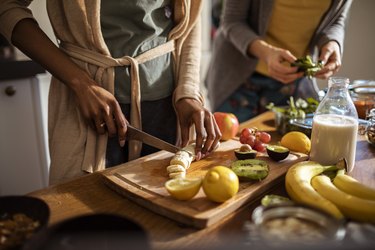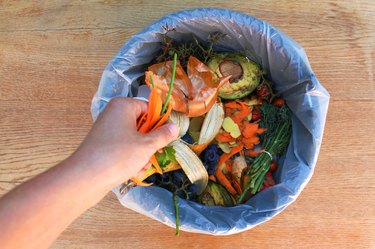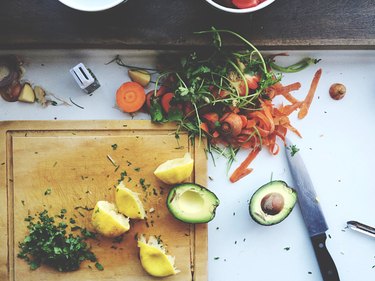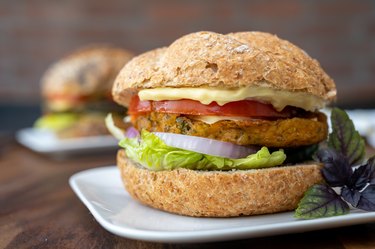
They say one person's trash is another person's treasure. It turns out you may be trashing some high-potential treasure in your own home when you toss scraps like potato peels, kale stems and strawberry leaves.
Knowing what to do with these kinds of food items may be the key to sustainability at home, and could also help your health.
Video of the Day
Video of the Day
These often-neglected vegetable and fruit parts are just as nutrient-dense as their commonly used counterparts, and you're seriously missing out on their flavor and texture if you're just throwing them away.
Upcycling, which is the practice of repurposing something deemed unusable into a new form, is not only a sustainable way to reduce waste but can also help you save hard-earned dollars. Households can save about $370 per person every year from upcycling and reducing food waste, according to the USDA.
"Less food ends up in a landfill or compost and we have more food to eat for the same price paid," says Abby K. Cannon, RD, CDN and founder of Abby's Food Court. So don't just throw away perfectly good parts of fruits and vegetables simply because you're not used to eating them.
How Much Food Are We Really Wasting, and Why Does It Matter?

Upcycling food scraps can make a significant environmental impact by reducing the build-up of greenhouse gases like methane. Many don't realize that food waste in landfills produces methane gas and that the nutrients in wasted food don't get absorbed by the soil.
Methane gas emissions is one of the leading causes of climate change. In fact, about 25 percent of man-made global warming is due to methane emissions, according to the Environmental Defense Fund (EDF).
So just how much does food waste contribute to methane emissions? In 2018 alone, the Environmental Protection Agency (EPA) reported that Americans wasted 63 million tons of food. And food accounts for 22 percent of the waste in landfills. The Food and Drug Administration (FDA) also notes that food waste in the U.S. is 30 to 40 percent of the food supply.
An April 2018 study in PLOS One showed that Americans wasted 150,000 tons of food per day — that's about a pound of food per person daily.
When researchers evaluated the top 22 food groups in landfills, including dairy and meat, they found that fruits and vegetables — true nutritional powerhouses — were being wasted in larger quantities than other types of food. But by practicing upcycling at home, people can make a big difference in preventing food waste.
"Eating the rainbow is a great way to think about upcycling. The more colors we have on our plates, the greater the variety of nutrients we ingest."
In April 2019, the USDA, EPA and FDA partnered with ReFED, Inc., a nonprofit that focuses on reducing U.S. food waste, to create solutions and strategies to decrease food loss.
According to ReFED's Roadmap to Reduce U.S. Food Waste by 20 Percent report, 13.2 million tons, or over 20 percent of food waste, can be cut over the next decade through community composting, cold-chain management and other recycling solutions. Some of ReFED's solutions also include upcycling food scraps into other food products, such as soups, sauces and jams.
Upcycled Food Gives You More Nutrients
Aside from promoting sustainability and cutting costs, upcycling taps a plethora of health benefits by making use of the entire plant.
"Consuming more of the vegetables we purchase provides us with a greater variety of nutrients and fiber for optimal health," Cannon says.
"By making use of the entire fruit and/or vegetable, we increase our meals' nutrient value without much added effort. It's a win-win."
For example, beet greens are a good source of iron, calcium, magnesium, zinc, fiber and even some protein.
"Considering that 95 percent of Americans don't get the recommended amount of fiber daily, using food scraps can help you reach your fiber intake goals," she adds. FYI, the Dietary Guidelines recommend that adults get 25 to 30 grams of fiber daily.
"Eating the rainbow is a great way to think about upcycling. The more colors we have on our plates, the greater the variety of nutrients we ingest," Cannon says.
Different parts of fruits and vegetables contain an array of nutrients, including vitamins, minerals, antioxidants and phytochemicals. "By making use of the entire fruit and/or vegetable, we increase our meals' nutrient value without much added effort. It's a win-win," she says.
How to Practice Upcycling at Home

Kickstarting an upcycling routine at home isn't a painstaking process, but it begins with some planning and focus. Before you even hit the grocery store, you'll want to think about how you can maximize all the parts of the produce you're planning to purchase.
"When we purchase fresh produce, we pay by the pound. This means we pay for the whole fruit or vegetable regardless of how much of it we actually consume," Cannon reminds us.
1. Use Scraps to Make a Tasty Broth
If carrots, chicken and parsley are on your list, consider repurposing the carrot leaves, chicken bones, and leftover parsley to prepare a chicken broth for soups and stews later in the week.
You can freeze extra broth for quick make-ahead meals the next time you're in a pinch. Cannon recommends collecting food scraps in a container or reusable bag and storing it in the freezer. Once the container or bag is filled, you can use all the scraps to make a stock.
2. Save the Stalks
Sometimes you have to think beyond your go-to recipes and get creative with your food scraps. For example, the stalks of kale and broccoli is one of the most neglected vegetable parts, but these scraps can be reinvented into sauces and salads for added flavor and nutrition.
"I always use vegetable stalks by chopping them up finely and cooking them with the rest of the dish," Cannon says. Sautéing the stalks in some extra-virgin olive oil helps break down their tough fibers, yielding a much softer and chewy texture that you can add to any dish.
3. Be Mindful of How You Chop Veggies
"I see people often cut the ends off vegetables too generously. I make sure to get as much of the fruit or vegetable as possible when I prepare food," Cannon says.
"If I'm roasting broccoli, I roast the chopped pieces of stalk right with the florets. I use herb stems in stews and soups, which provides extra flavor and nutrients," she adds. She also likes to add the greens on beets and cauliflower to a delicious stir-fry, pesto or egg scramble.
4. Keep Veggie Peels on or Repurpose Them
If a recipe calls for peeling potatoes, Cannon simply skips that step, or she saves the peels to prepare homemade chips.
"Fry the peels in a pan with some avocado oil and salt until they are super crispy. They are delicious!," she says. The same goes for seeds in squashes. Instead of throwing them away, toss them in some avocado oil with your own mix of spices or herbs and roast them in the oven for a savory snack.
5. Don’t Toss Fruit Scraps, Either
Cannon throws the green tops of strawberries in her smoothies to add more fiber. If you make homemade juices and plant-based milks, Cannon suggests using the leftover pulp to infuse texture and fiber into your dishes.
"The pulp from juices and nut milks, like almond, cashew or oat milk, can be used to prepare baked goods, or you can feed it to your pets," she says (just make sure to check with your vet before feeding your pet new foods). "You can also mix the pulp from plant-based milks in oatmeal or cereal."
Plus, you can use the pulp to make your own veggie burgers. Combine them with grains and beans and season them with a combination of herbs and spices. Then, form them into patties and pan-fry them on a skillet with some extra-virgin olive oil.

6 Tasty Upcycled Snacks for Convenient Sustainability
Want to jump on the upcycling trend on the go? Here are some healthy snack brands that are reimagining food scraps, making it convenient for you to participate.
"It's great to support brands that are making good use of scraps. They put a lot of effort into saving food and also making it delicious," Cannon says.
1. Rind Snacks
Per 1.5-ounce serving: 130 calories, 0 grams fat (0 grams saturated fat), 0 milligrams sodium, 31 grams carbohydrates (7 grams fiber, 15 grams sugar, 0 grams added sugar), 2 grams protein
Fruit rinds are one of fruits' most neglected parts, but these sun-dried snacks force you to think beyond the flesh to reap the nutrients in fruits. Their tropical blend snack is bursting with the sweet, zesty flavors of kiwis, oranges and pineapples, while offering their superb fiber and antioxidant power.
"Rind makes great dried fruit snacks, using all of the fruit, including the nutrient-rich peels! By consuming these, you'll get an extra hit of antioxidants and phytochemicals," Cannon says.
Buy it: Amazon.com; Price: $18.49 (pack of 3)
2. Barnana
Per 1.4-ounce serving: 115 calories, 0 grams fat (0 grams saturated fat), 0 milligrams sodium, 27 grams carbohydrates (4 grams fiber, 17 grams sugar, 0 grams added sugar), 2 grams protein
Barnana partners with local farms in Latin America to upcycle more than 85 million bananas to create plantain chips, peanut butter banana bites and banana brittle. Their delicious bite-sized banana-and-peanut-butter morsels deliver quick energy for an afternoon pick-me-up or pre-workout snack.
"Barnana's products tackle food waste right from farms. The whole food industry and the entire lifecycle of food from farm to plate also massively contributes to waste," Cannon says. With these snacks, you not only support a great initiative but you get a sweet fix, too.
Buy it: Amazon.com; Price: $13.50 (pack of 3)
3. ZenB
Per pouch: 130 calories, 5 grams fat (0.5 grams saturated fat), 45 milligrams sodium, 19 grams carbohydrates (5 grams fiber, 9 grams sugar, 6 grams added sugar), 3 grams protein
ZenB refers to the Japanese expression "zenbu," which means "whole." ZenB's snacks live up to this guiding principle by using every part of vegetables and fruits, including their core, peel, seeds and stems.
"Eating a greater variety of plants and more of the plants that we don't typically consume increases how much nutrition we get from those plants," Cannon says.
Buy it: ZenB.com; Price: $29.99 (pack of 10)
4. WTRMLN WTR
Per 12-ounce serving: 70 calories, 0 grams fat (0 grams saturated fat), 10 milligrams sodium, 18 grams carbohydrates (0 grams fiber, 18 grams sugar, 0 grams added sugar), 1 gram protein
Similar to Barnana, WRMLN WTR rescues blemished watermelons and transforms them into a refreshingly sweet sports drink.
"This helps the farmers, who now have a market for imperfect melons, and reduces food waste," Cannon says. With flavors like ginger, strawberry, blood orange and cucumber, these hydrating beverages deliver essential electrolytes post-workout for only 1 gram of sugar.
Buy it: Instacart.com; Price: $2.98
5. Sir Kensington Classic Vegan Mayo
Per 1 tablespoon: 90 calories, 10 grams fat (0.5 grams saturated fat), 90 milligrams sodium, 0 grams carbohydrates (0 grams fiber, 0 grams sugar, 0 grams added sugar), 0 grams protein
Aquafaba — the liquid in canned chickpeas — is popping up in tons of vegan food products because it works well as a binder in place of eggs in vegan-friendly dishes. Aquafaba saves a byproduct of cooking beans that usually would be thrown away, Cannon says.
Sir Kensington cleverly makes use of aquafaba in its egg-free mayo, which also features lemon juice and vinegar for flavor.
Buy it: Amazon.com; Price: $6.32
6. ReGrained
Per 1 bar: 160 calories, 6 grams fat (0.5 grams saturated fat), 75 milligrams sodium, 25 grams carbohydrates (5 grams fiber,, 8 grams sugar), 4 grams protein
When beer is brewed, tons of grains are used and often go to waste. But ReGrained reimagines the grains in the beer brewing process, featuring them in puffed snacks in mouth-watering flavors such as Mexican Street Corn and Texas Pit BBQ.
Buy it: Amazon.com; Price: $13.99 (pack of 3)
Upcycling Practices in Restaurants
As sustainability becomes top of mind for consumers, many restaurateurs and food manufacturers have adopted the upcycling trend.
The juice shop Juice Press, for example, upcycles pulp from their cold-pressed juices to make their organic soups and kale pesto. Their compostable smoothie cups, bowls and straws are made from sugarcane pulp.
Other fast-casual outposts like Sweetgreen and Dig (formerly Dig Inn) have partnered with local farms to rescue blemished produce and implemented food preparation and cooking techniques that help minimize waste.
- American Journal of Lifestyle Medicine: Closing America's Fiber Gap Intake
- USDA: 2015-2020 Dietary Guidelines
- EDF: Methane: The Other Important Greenhouse Gas
- EPA: "Sustainable Management of Basics"
- PLOS ONE: Relationship Between Food Waste, Diet Quality, and Environmental Sustainability
- ReFed: 27 Solutions to Food Waste